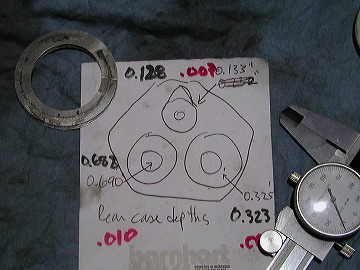
According to the manual, this clearance needs to include the thickness of a gasket, nominally about .006 inch. But again, Jack Lawrence gave me different advice. He suggests omitting the gasket and instead choosing shims that will allow only .002 inch gap between the case and the rear cover. He recommends using non-high-temp Dow Corning silicone sealer to seal the cover to the case, instead of the gasket.
Why no gasket? Lawrence explains it this way: if you use a gasket and it fails, you've got a gap .006 inch thick by the length of the break. This is a good-size hole, through which gear lubricant could leak out quickly. If it should leak out before you noticed it, you could ruin the gearbox.
Omitting the gasket and setting the clearance to .002 inch makes for a much thinner gap in case of a break. That gap will leak much more slowly, giving you more chance to notice it. And, Lawrence said, simply retightening the rear-cover bolts may be enough to seal up the leak.